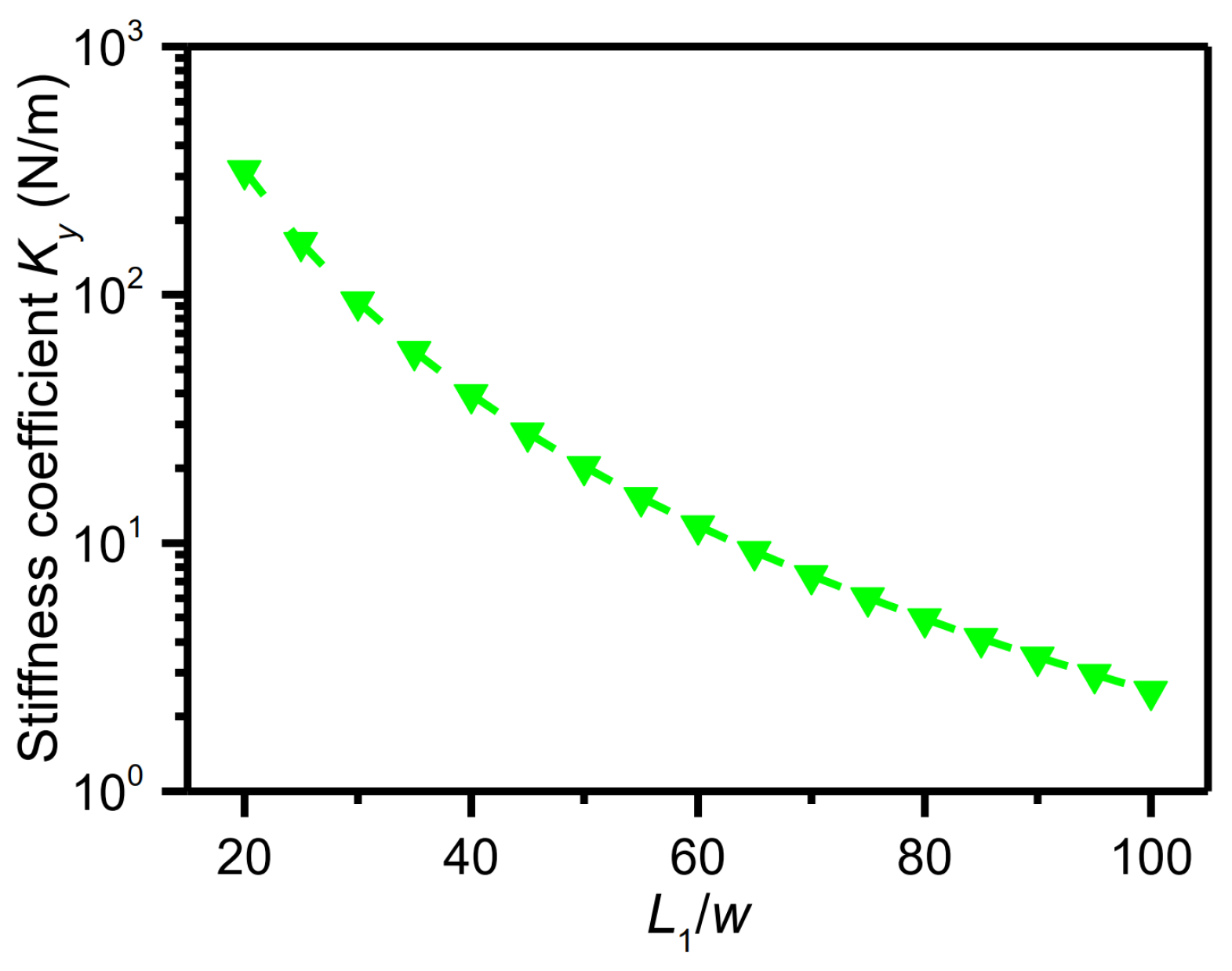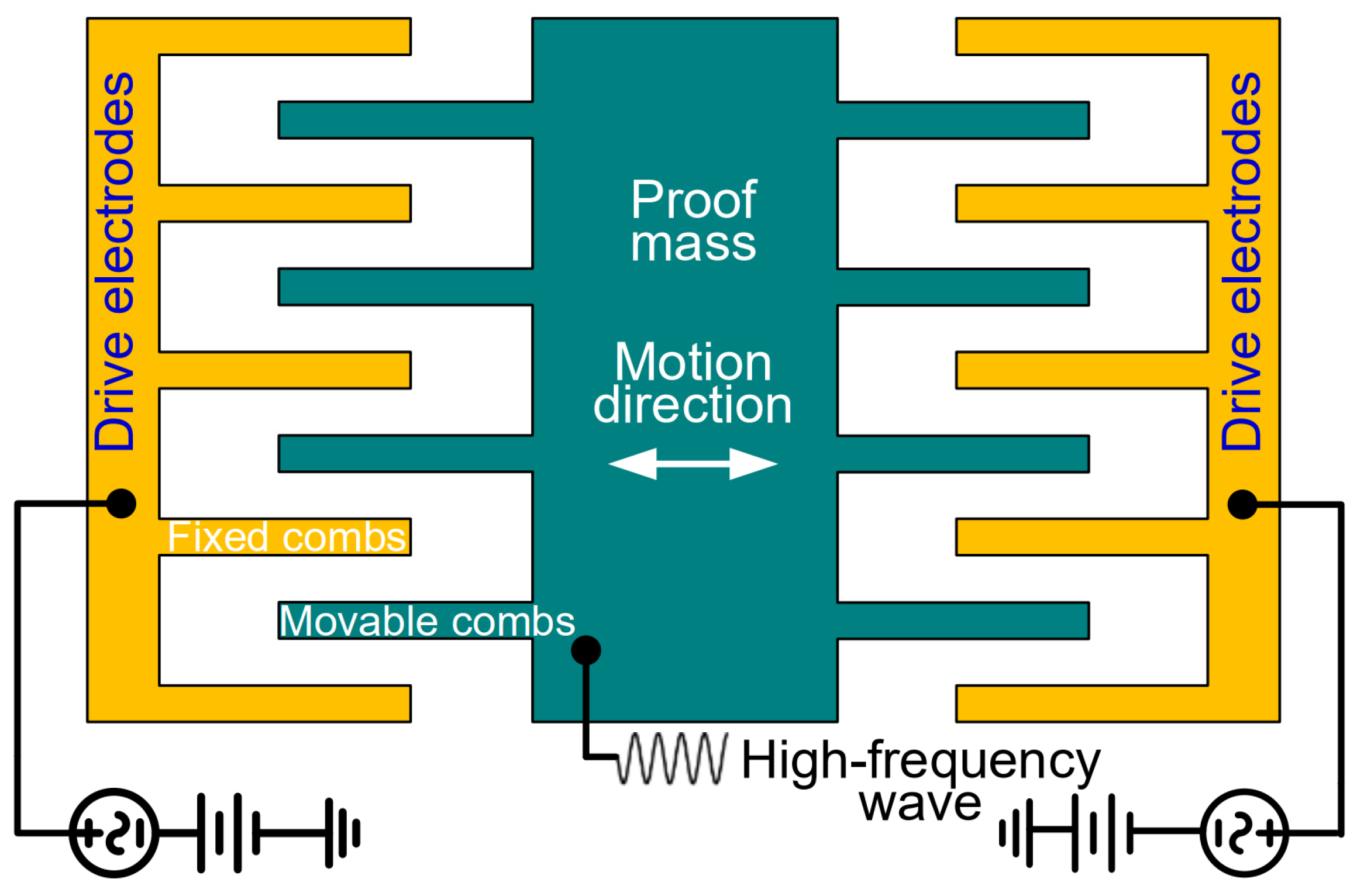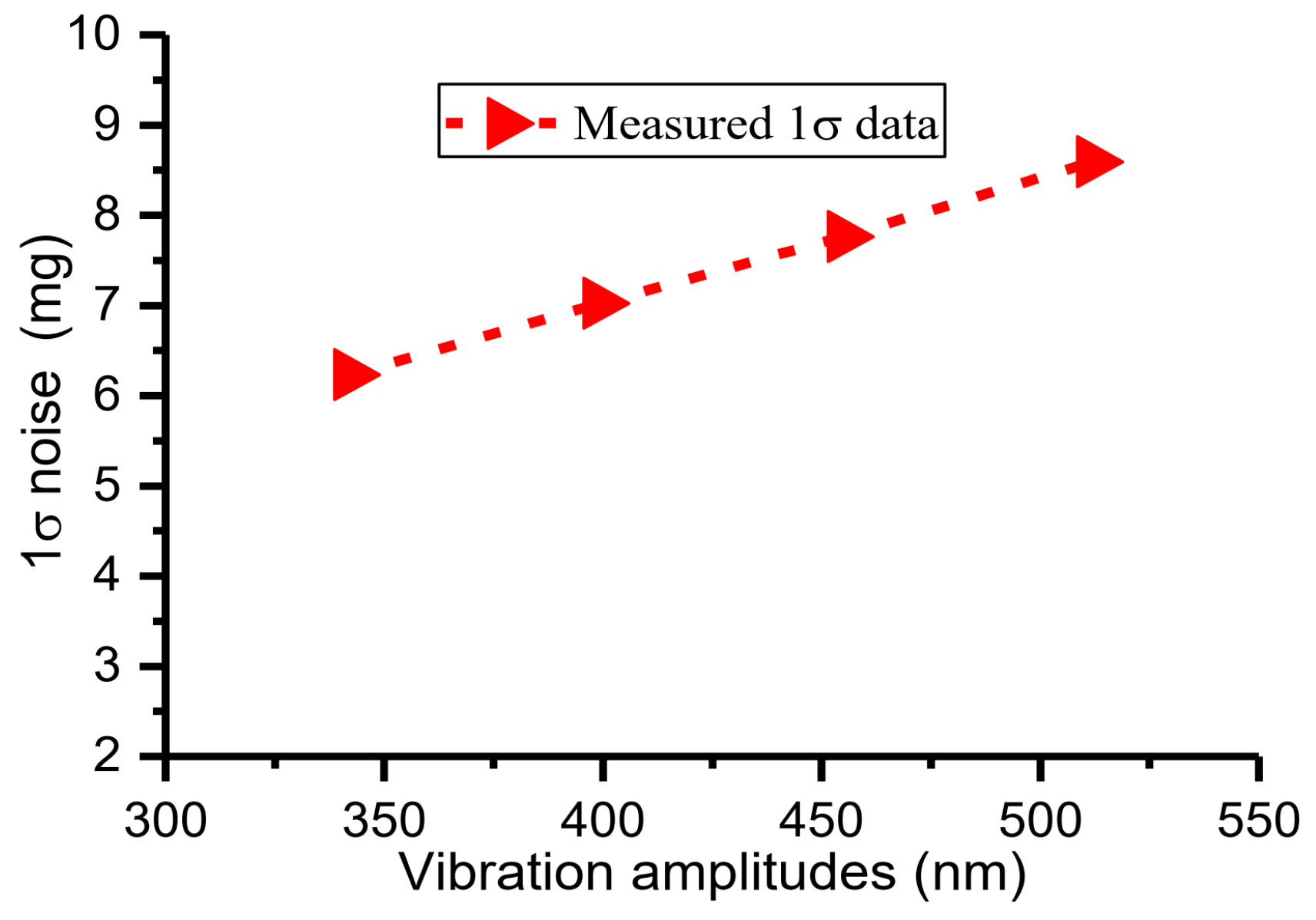Top-Down Design Method of a Time Domain Accelerometer with Adjustable Resolution
Abstract
:1. Introduction
2. Adjustable Resolution of Time Domain Accelerometer
3. Design and Fabrication of a Time Domain Accelerometer Device with Adjustable Resolution
3.1. Design of a Time Domain Accelerometer Device
3.1.1. Overall Design
3.1.2. Elastic Beam
3.1.3. Electrostatic Driving Structure
3.1.4. Detection Structure of the Oscillation Trajectory of the Proof Mass
3.2. Fabrication of Time Domain Sensor Device Using One Photomask
4. Detection Method of Developed Time Domain Acceleration Sensor
4.1. Push–Pull Electrostatic Drive Circuit
4.2. Detection Circuit of the Oscillation Trajectory of the Proof Mass
4.2.1. Representation of DRPs
4.2.2. Relationship between Displacement and Capacitance
4.2.3. Differential Capacitance Detection Method of Suppressing the Same-Frequency Interference
4.3. Time Intervals Measurement Based on Data Post-Processing
5. Measurement Results and Discussion
5.1. Dependence of Acceleration Resolution on Time-Measurement Accuracy and Vibration Amplitude
5.1.1. Dependence of the Acceleration Resolution on the Time-Measurement Accuracy
5.1.2. Dependence of the Acceleration Resolution on the Vibration Amplitudes
6. Conclusions
Author Contributions
Funding
Data Availability Statement
Conflicts of Interest
References
- Bijjahalli, S.; Sabatini, R.; Gardi, A. Advances in intelligent and autonomous navigation systems for small UAS. Prog. Aerosp. Sci. 2020, 115, 100617. [Google Scholar] [CrossRef]
- Wang, C.; Hao, Y.; Sun, Z.; Zu, L.; Yuan, W.; Chang, H. Design of a Capacitive MEMS Accelerometer with Softened Beams. Micromachines 2022, 13, 459. [Google Scholar] [CrossRef] [PubMed]
- Zhang, C.; Chen, J.; Li, J.; Peng, Y.; Mao, Z. Large language models for human–robot interaction: A review. Biomim. Intell. Robot. 2023, 3, 100131. [Google Scholar] [CrossRef]
- Mao, Z.; Peng, Y.; Hu, C.; Ding, R.; Yamada, Y.; Maeda, S. Soft computing-based predictive modeling of flexible electrohydrodynamic pumps. Biomim. Intell. Robot. 2023, 3, 100114. [Google Scholar] [CrossRef]
- Kang, H.; Ruan, B.; Hao, Y.; Chang, H. Mode-localized accelerometer with ultrahigh sensitivity. Sci. China Inf. Sci. 2022, 65, 1–13. [Google Scholar] [CrossRef]
- Roylance, L.M.; Angell, J.B. A batch-fabricated silicon accelerometer. IEEE Trans. Electron Devices 1979, 26, 1911–1917. [Google Scholar] [CrossRef]
- Levinzon, F.A. Ultra-low-noise seismic piezoelectric accelerometer with integral FET amplifier. IEEE Sens. J. 2012, 12, 2262–2268. [Google Scholar] [CrossRef]
- Roessig, T.A.; Howe, R.T.; Pisano, A.P.; Smith, J.H. Surface-micromachined resonant accelerometer. In Proceedings of the Proceedings of Transducers 1997, Chicago, IL, USA, 19 June 1997; IEEE: Piscataway, NJ, USA, 1997; pp. 859–862. [Google Scholar]
- Zu, L.; Hao, Y.; Wang, M.; Chang, H. A Novel Mode-Localized Accelerometer Employing a Tunable Annular Coupler. IEEE Sens. J. 2022, 22, 6426–6434. [Google Scholar] [CrossRef]
- Zhang, H.; Yuan, W.; Hao, Y.; Chang, H. Influences of the feedthrough capacitance on the frequency synchronization of the weakly coupled resonators. IEEE Sens. J. 2015, 15, 6081–6088. [Google Scholar] [CrossRef]
- Rockstad, H.K.; Tang, T.; Reynolds, J.; Kenny, T.; Kaiser, W.; Gabrielson, T.B. A miniature, high-sensitivity, electron tunneling accelerometer. Sens. Actuators A Phys. 1996, 53, 227–231. [Google Scholar] [CrossRef]
- Li, P.; Shen, Q.; Chang, H.; Li, E. High-accuracy silicon-on-insulator accelerometer with an increased yield rate. Micro Nano Lett. 2015, 10, 477–482. [Google Scholar] [CrossRef]
- Dalola, S.; Ferrari, V.; Marioli, D. Micromachined piezoresistive inclinometer with oscillator-based integrated interface circuit and temperature readout. Meas. Sci. Technol. 2012, 23, 035107. [Google Scholar] [CrossRef]
- Wang, Y.; Ding, H.; Le, X.; Wang, W.; Xie, J. A MEMS piezoelectric in-plane resonant accelerometer based on aluminum nitride with two-stage microleverage mechanism. Sensors Actuators A Phys. 2017, 254, 126–133. [Google Scholar] [CrossRef]
- Wojciechowski, K.E.; Boser, B.E.; Pisano, A.P. A MEMS resonant strain sensor operated in air. In Proceedings of the Proceedings of IEEE MEMS 2004, Maastricht, The Netherlands, 25–29 January 2004; IEEE: Piscataway, NJ, USA, 2004; pp. 841–845. [Google Scholar]
- Ferrari, V.; Ghisla, A.; Marioli, D.; Taroni, A. Silicon resonant accelerometer with electronic compensation of input-output cross-talk. Sens. Actuators A Phys. 2005, 123–124, 258–266. [Google Scholar] [CrossRef]
- Zhang, H.; Li, B.; Yuan, W.; Kraft, M.; Chang, H. An Acceleration Sensing Method Based on the Mode Localization of Weakly Coupled Resonators. J. Microelectromech. Syst. 2016, 25, 286–296. [Google Scholar] [CrossRef]
- Analog Surface Mount Accelerometer Model 1521. Available online: https://drive.google.com/file/d/0B4eVto02URUhYnQ0RXMtUHNpUlU/view (accessed on 1 February 2024).
- Three Axis Accelerometer B-290 TRIAD. Available online: https://northropgrumman.litef.com/fileadmin/downloads/Datenblaetter/Datenblatt_B-290.pdf (accessed on 1 February 2024).
- Single Axis Analog Accelerometer MS1002. Available online: https://www.colibrys.com/wp-content/uploads/2016/12/30s-ms1000-e-04-18-datasheet.pdf (accessed on 1 February 2024).
- Furubayashi, Y.; Oshima, T.; Yamawaki, T.; Watanabe, K.; Mori, K.; Mori, N.; Matsumoto, A.; Kamada, Y.; Isobe, A.; Sekiguchi, T. A 22-ng/√ Hz 17-mW Capacitive MEMS Accelerometer with Electrically Separated Mass Structure and Digital Noise- Reduction Techniques. IEEE J. Sol.-State Circuits 2020, 55, 2539–2552. [Google Scholar] [CrossRef]
- Xu, H.; Liu, X.; Yin, L. A Closed-Loop Interface for a High-Q Micromechanical Capacitive Accelerometer with 200 ng/Hz Input Noise Density. IEEE J. Sol. State Circuits 2015, 50, 2101–2112. [Google Scholar] [CrossRef]
- Li, E.; Jian, J.; Yang, F.; Ma, Z.; Hao, Y.; Chang, H. Characterization of Sensitivity of Time Domain MEMS Accelerometer. Micromachines 2024, 15, 227. [Google Scholar] [CrossRef] [PubMed]
- Li, E.; Zhang, L.; Guan, X.; Hao, Y.; Shen, Q.; Chang, H. Novel acceleration measurement method during attenuation vibration of inertial sensor based on time domain sensing mechanism. Measurement 2023, 218, 113077. [Google Scholar] [CrossRef]
- Hinkley, N.; Sherman, J.A.; Phillips, N.B.; Schioppo, M.; Lemke, N.D.; Beloy, K.; Pizzocaro, M.; Oates, C.W.; Ludlow, A.D. An atomic clock with 10-18 instability. Science 2013, 341, 1215–1218. [Google Scholar] [CrossRef]
- Swanson, P.D.; Tally, C.H.; Waters, R.L. Proposed digital, auto ranging, self calibrating inertial sensor. In Proceedings of the IEEE Sensors 2011, Limerick, Ireland, 28–31 October 2011; IEEE: Piscataway, NJ, USA, 2011; pp. 1457–1460. [Google Scholar]
- Swanson, P.D.; Tally, C.H.; Waters, R.L. Apparatus and Method for Providing an In-Plane Inertial Device with Integrated Clock. U.S. Patent 8,875,576, 4 November 2014. [Google Scholar]
- Diego, S. Intelligent Polynomial Curve Fitting for Time-Domain Triggered Inertial Devices. In Proceedings of the 2012 IEEE/ION Position, Location and Navigation Symposium, Myrtle Beach, SC, USA, 23–26 April 2012; IEEE: Piscataway, NJ, USA, 2012. [Google Scholar]
- Sabater, A.B.; Swanson, P. Angular Random Walk Estimation of a Time-Domain Switching Micromachined Gyroscope; Technology Digest: Rockville, MD, USA, 2016. [Google Scholar]
- Li, E.; Shen, Q.; Hao, Y.; Chang, H. A Virtual Accelerometer Array Using One Device Based on Time Domain Measurement. IEEE Sens. J. 2019, 19, 6067–6075. [Google Scholar] [CrossRef]
- National Instruments. DAQ S Series User Manuscript. Available online: https://www.ni.com/docs/zh-CN/bundle/ni-611x-612x-613x-6143-features/resource/370781h.pdf (accessed on 1 February 2024).
- Fedder, G.K. Simulation of Microelectromechanical Systems; University of California at Berkeley: Berkeley, CA, USA, 1994. [Google Scholar]




















| Parameters | Value |
|---|---|
| Desired acceleration resolution | ~5 mg |
| Resonant frequency | 1.2 kHz |
| Maximum vibration amplitude | 584 nm |
| Highest time-measurement accuracy | 400 ns |
| Size | 3.5 mm × 4 mm |
| Sensing mass | 1.8 × 10−7 kg |
| Parameters | Value (μm) |
|---|---|
| 700 | |
| 700 | |
| 30 | |
| 10 | |
| 30 | |
| 30 |
| Parameters | Value (μm) |
|---|---|
| 5 | |
| 40 | |
| 2.5 | |
| 25 |
| Parameters | Value (μm) |
|---|---|
| 2.5 | |
| 7.5 | |
| 3 | |
| 60 | |
| 6 |
Disclaimer/Publisher’s Note: The statements, opinions and data contained in all publications are solely those of the individual author(s) and contributor(s) and not of MDPI and/or the editor(s). MDPI and/or the editor(s) disclaim responsibility for any injury to people or property resulting from any ideas, methods, instructions or products referred to in the content. |
© 2024 by the authors. Licensee MDPI, Basel, Switzerland. This article is an open access article distributed under the terms and conditions of the Creative Commons Attribution (CC BY) license (https://creativecommons.org/licenses/by/4.0/).
Share and Cite
Li, E.; Jian, J. Top-Down Design Method of a Time Domain Accelerometer with Adjustable Resolution. Micromachines 2024, 15, 635. https://doi.org/10.3390/mi15050635
Li E, Jian J. Top-Down Design Method of a Time Domain Accelerometer with Adjustable Resolution. Micromachines. 2024; 15(5):635. https://doi.org/10.3390/mi15050635
Chicago/Turabian StyleLi, Enfu, and Jiaying Jian. 2024. "Top-Down Design Method of a Time Domain Accelerometer with Adjustable Resolution" Micromachines 15, no. 5: 635. https://doi.org/10.3390/mi15050635







